The PP Nonwovens Market is estimated to be valued at USD 33.0 billion in 2025 and is projected to reach USD 58.0 billion by 2035, registering a compound annual growth rate (CAGR) of 5.8% over the forecast period. This growth reflects a steady CAGR of 5.8%, driven by increasing demand for nonwoven fabrics in various applications such as hygiene products, medical textiles, automotive, and construction.
In the first five-year phase (2025 to 2030), the market is expected to grow from USD 33 billion to USD 43 billion, adding USD 10 billion, which accounts for 40% of the total incremental growth, as the adoption of nonwoven materials continues to rise in emerging markets and established sectors.
The second phase (2030 to 2035) contributes USD 15 billion, representing 60% of incremental growth, driven by the expanding use of PP nonwoven materials in industrial, medical, and consumer applications. Annual increments increase from USD 2 billion in early years to USD 3 billion by 2035, reflecting the growing preference for sustainable, cost-efficient, and versatile nonwoven products. Manufacturers focusing on innovation, eco-friendly alternatives, and advanced applications will capture the largest share of this USD 25 billion opportunity.
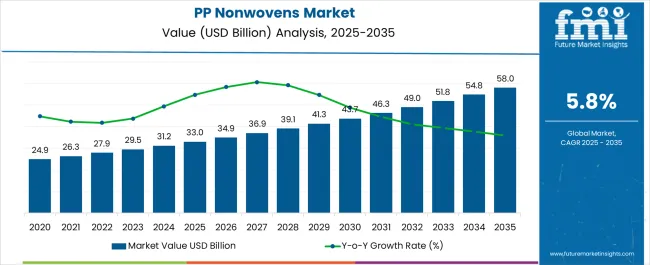
| Metric | Value |
|---|---|
| PP Nonwovens Market Estimated Value in (2025 E) | USD 33.0 billion |
| PP Nonwovens Market Forecast Value in (2035 F) | USD 58.0 billion |
| Forecast CAGR (2025 to 2035) | 5.8% |
The PP Nonwovens market is advancing steadily, supported by increasing demand from hygiene, healthcare, and industrial applications. Rising awareness of personal hygiene, coupled with growing disposable incomes and changing lifestyles, has fueled consistent growth across both developed and emerging markets.
Industry developments and corporate initiatives indicate a strong shift toward lightweight, cost-effective, and high-performance materials, which have positioned polypropylene nonwovens as a preferred choice in disposable hygiene products and medical supplies. Innovations in production processes and sustainability-driven material optimization are paving the way for improved quality, lower environmental impact, and enhanced usability.
Future growth opportunities are being shaped by regulatory emphasis on biodegradable and recyclable materials, coupled with expanding applications beyond hygiene into agriculture, automotive, and construction. The combination of functional versatility, economic efficiency, and alignment with evolving consumer needs continues to underpin the market’s upward trajectory.
The PP Nonwovens market is segmented by product, application, end-user, and geographic regions. The product of the PP Nonwovens market is divided into Spunbond PP Nonwovens, Meltblown PP Nonwovens, and Composite (e.g., SMS, SMMS). In terms of application, the PP Nonwovens market is classified into Hygiene (baby diapers, feminine hygiene, adult incontinence), Medical (surgical gowns, masks, drapes), Industrial (geotextiles, filters, insulation), Automotive, and Packaging.
Based on the end-user of the PP Nonwovens market, it is segmented into Personal Care & Hygiene, Healthcare & Medical, Industrial & Construction, Automotive, and Agriculture. Regionally, the PP Nonwovens industry is classified into North America, Latin America, Western Europe, Eastern Europe, Balkan & Baltic Countries, Russia & Belarus, Central Asia, East Asia, South Asia & Pacific, and the Middle East & Africa.
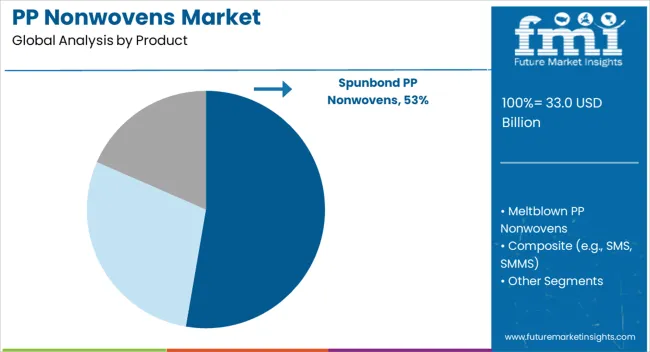
When segmented by product, the spunbond PP nonwovens segment is projected to hold 52.70% of the total market revenue in 2025, establishing itself as the leading product category. This dominance is attributed to its efficient manufacturing process, which enables high output, consistent quality, and cost competitiveness compared to alternative technologies.
The segment’s growth has been reinforced by its ability to produce fabrics with superior tensile strength, breathability, and softness, which are crucial in hygiene and medical applications. Continuous advancements in machinery and process automation have also enhanced production efficiency and reduced operational costs, making spunbond nonwovens a preferred choice for large-scale production.
The segment’s versatility in weight and structure further supports its use across a wide range of end uses, cementing its leadership position in the PP Nonwovens market.
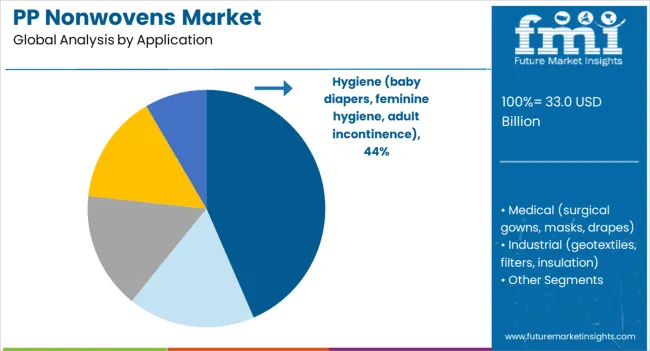
In terms of application, the hygiene segment, comprising baby diapers, feminine hygiene, and adult incontinence products, is expected to account for 43.5% of the market revenue in 2025, making it the most significant application segment. The segment’s prominence is driven by rising global awareness of personal hygiene, demographic trends such as aging populations, and increasing birth rates in developing regions.
The hygienic performance and skin-friendliness of PP nonwovens have positioned them as indispensable in disposable absorbent products. Investments in innovative, softer, and more breathable fabrics have enhanced user comfort and product differentiation, further bolstering demand.
Regulatory focus on product safety and the growing penetration of branded hygiene products in underserved markets have also contributed to this segment’s expansion. Enhanced production capabilities and continuous product development have enabled manufacturers to cater to evolving consumer preferences, ensuring sustained growth of the hygiene application segment.
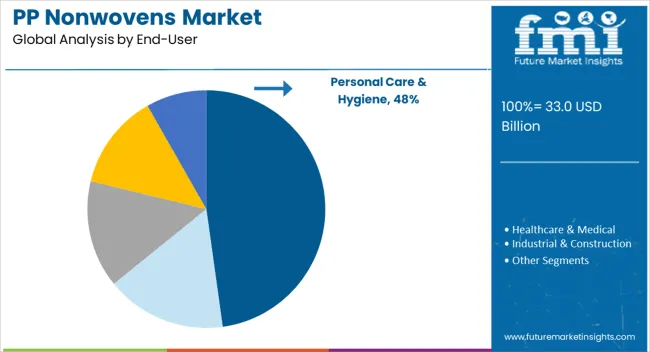
When segmented by end user, the personal care and hygiene segment is forecast to capture 47.8% of the market revenue in 2025, maintaining its position as the leading end user category. This leadership is supported by the critical role PP nonwovens play in meeting the functional requirements of disposable hygiene products.
The segment’s growth has been fueled by rising consumer demand for high-quality, safe, and convenient products, supported by robust distribution networks of global and regional brands. Enhanced manufacturing scale and innovations in material properties such as softness, absorbency, and barrier performance have allowed producers to meet diverse market needs efficiently.
The ability of PP nonwovens to enable cost-effective production while adhering to stringent hygiene standards has strengthened their adoption within this segment. Continuous focus on sustainability, combined with efforts to improve product aesthetics and user experience, has reinforced the dominance of personal care and hygiene as the primary end user of PP nonwovens.
PP Nonwovens market is driven by the growing demand for lightweight, durable materials in industries like hygiene, automotive, and construction. Opportunities in these sectors are fueling growth, while trends toward biodegradable and eco-friendly nonwovens are reshaping the market. However, challenges such as volatile raw material prices and high production costs could limit growth. By 2025, overcoming these barriers through efficient production and alternative material sourcing will be essential for continued market success.
PP Nonwovens market is expanding due to the increasing demand for lightweight, durable, and cost-effective materials across various industries, including hygiene, automotive, and construction. Polypropylene nonwovens are favored for their excellent filtration, absorption, and strength properties, making them ideal for applications in medical products, diapers, and geotextiles. By 2025, the market will continue benefiting from this demand for versatile, high-performance materials that meet the growing need for efficient, long-lasting products.
Opportunities in PP Nonwovens market are rising, particularly in the automotive and hygiene sectors. In the automotive industry, PP nonwovens are increasingly used in interior applications like soundproofing and air filtration. The hygiene sector is expanding, with a growing demand for diapers, feminine hygiene products, and adult incontinence solutions. By 2025, these industries are expected to continue driving the growth of PP nonwoven materials, as manufacturers seek efficient, lightweight materials for a wide range of applications.
Emerging trends in PP Nonwovens market include a shift toward biodegradable and eco-friendly nonwoven materials. With rising consumer demand for environmentally responsible products, manufacturers are exploring alternative, biodegradable fibers for nonwoven fabrics. These eco-friendly nonwovens can be used in applications like packaging and personal care items, which contribute to reducing plastic waste. By 2025, these sustainable trends will shape the market, as both manufacturers and consumers prioritize greener options.
Despite market growth, challenges related to volatile raw material prices and high production costs remain significant. The price fluctuations of polypropylene, a key raw material for nonwoven fabrics, can disrupt production costs and affect profitability. Additionally, the complexity of manufacturing high-quality nonwoven materials adds to operational expenses. By 2025, addressing these challenges through cost-efficient production techniques and stable sourcing strategies will be essential for sustaining growth and improving profit margins.
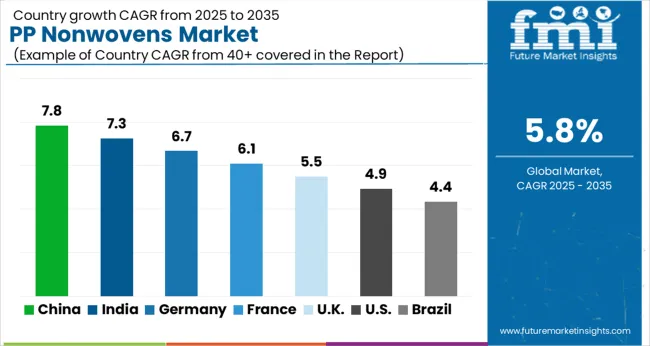
| Country | CAGR |
|---|---|
| China | 7.8% |
| India | 7.3% |
| Germany | 6.7% |
| France | 6.1% |
| UK | 5.5% |
| USA | 4.9% |
| Brazil | 4.4% |
The global PP nonwovens market is projected to grow at a 5.8% CAGR from 2025 to 2035. China leads with a growth rate of 7.8%, followed by India at 7.3%, and Germany at 6.7%. The United Kingdom records a growth rate of 5.5%, while the United States shows the slowest growth at 4.9%. These varying growth rates are driven by factors such as increasing demand for nonwoven materials in hygiene, automotive, medical, and filtration applications. Emerging markets like China and India are experiencing higher growth due to expanding manufacturing capabilities, industrialization, and rising consumer demand for sustainable and cost-effective nonwoven solutions, while more mature markets like the USA and the UK experience steady growth driven by established industries and the increasing adoption of eco-friendly products. This report includes insights on 40+ countries; the top markets are shown here for reference.
PP Nonwovens market in China is growing at an impressive rate, with a projected CAGR of 7.8%. China’s expanding manufacturing sectors, including automotive, hygiene products, medical applications, and filtration, are driving significant demand for PP nonwoven materials. The country’s rapid industrialization, increasing adoption of nonwoven technologies, and growing demand for cost-effective, eco-friendly materials in consumer products are key factors contributing to market growth. Additionally, government initiatives to promote sustainability in the manufacturing sector and the rise in disposable income further support the expansion of PP Nonwovens market in China.
PP Nonwovens market in India is projected to grow at a CAGR of 7.3%. India’s rapidly growing demand for nonwoven materials, driven by expanding industries such as hygiene, automotive, medical, and filtration, is contributing to market growth. The increasing preference for eco-friendly materials in packaging, medical disposables, and hygiene products is further accelerating the adoption of PP nonwovens. Additionally, India’s rising manufacturing capabilities, coupled with government support for sustainable industry practices and infrastructure development, are driving the demand for PP nonwovens in various sectors.
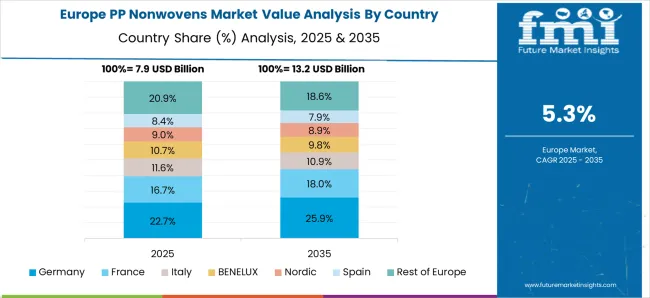
PP Nonwovens market in Germany is projected to grow at a CAGR of 6.7%. Germany’s strong manufacturing base, particularly in the automotive, medical, and hygiene sectors, continues to drive steady demand for PP nonwoven materials. The growing focus on sustainability, combined with the demand for lightweight, durable, and cost-effective materials, supports the market’s growth. Additionally, Germany’s regulatory environment, which promotes eco-friendly solutions and advanced production technologies, ensures the continued adoption of PP nonwovens in various applications. The country's leadership in automotive manufacturing and medical technology further accelerates the demand for high-performance nonwoven materials.
PP Nonwovens market in the United Kingdom is projected to grow at a CAGR of 5.5%. The UK is seeing steady demand for PP nonwoven materials in a variety of industries, particularly in hygiene products, medical applications, and packaging. The increasing emphasis on sustainability and reducing plastic waste is driving the demand for nonwoven materials, as they offer an eco-friendly alternative to traditional materials. Additionally, the growing trend of using nonwovens in filtration and automotive applications further accelerates market growth, with continued investments in manufacturing technologies supporting the adoption of PP nonwovens.
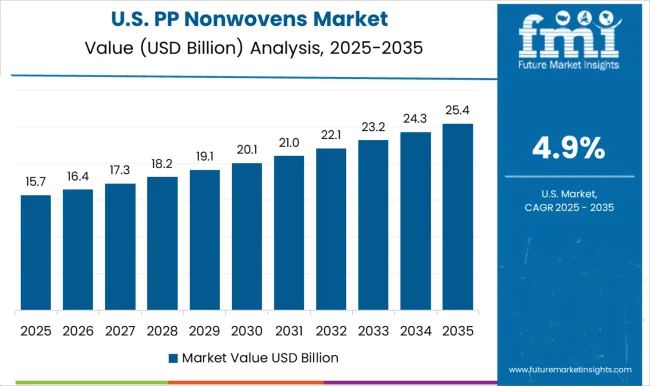
PP Nonwovens market in the United States is expected to grow at a CAGR of 4.9%. Despite being a mature market, the USA continues to see steady demand for PP nonwoven materials, particularly in industries such as hygiene, medical, automotive, and filtration. The rising focus on sustainable and eco-friendly materials, as well as the demand for cost-effective and high-performance nonwoven solutions, supports market growth. Additionally, the increasing adoption of nonwoven materials in medical and hygiene products, along with growing consumer awareness of environmental issues, is contributing to continued market expansion.

PP Nonwovens market is dominated by Freudenberg SE, which leads with its high-performance polypropylene (PP) nonwoven fabrics used across various industries, including hygiene, automotive, medical, and filtration. Freudenberg’s dominance is supported by its innovative technologies, global manufacturing capabilities, and commitment to sustainability in the production of lightweight, durable, and eco-friendly nonwovens.
Key players such as Dow, Dupont, and Kimberly-Clark maintain significant market shares by offering versatile PP nonwovens that provide superior performance, strength, and moisture management for diverse applications, including diapers, medical products, and industrial filtration. These companies focus on improving material efficiency, enhancing functionality, and expanding their product portfolios to meet the growing demand for sustainable, high-quality nonwoven fabrics.
Emerging players like Ahlstrom, Toray Industries, and Suominen Corporation are expanding their market presence by providing specialized PP nonwoven solutions for niche applications such as medical textiles, automotive interiors, and packaging. Their strategies include enhancing product properties, developing eco-friendly materials, and focusing on customization to address specific customer needs.
Market growth is driven by the increasing demand for sustainable and lightweight materials, the rise in hygiene product consumption, and growing industrial applications for nonwoven fabrics. Innovations in fiber technology, production processes, and the development of bio-based nonwovens are expected to continue shaping competitive dynamics and drive growth in the global PP nonwovens market.
In July 2025, Spunweb Nonwoven, a manufacturer of spunbond nonwoven fabrics, launched its initial public offering (IPO) on July 14. The IPO is a completely fresh issue comprising 63.52 lakh equity shares, with a target to raise ₹61 crore. The price band for the offering is set between ₹90 and ₹96 per share. The subscription window remained open until July 16, and the company's shares are scheduled to be listed on the NSE SME platform.
| Item | Value |
|---|---|
| Quantitative Units | USD 33.0 Billion |
| Product | Spunbond PP Nonwovens, Meltblown PP Nonwovens, and Composite (e.g., SMS, SMMS) |
| Application | Hygiene (baby diapers, feminine hygiene, adult incontinence), Medical (surgical gowns, masks, drapes), Industrial (geotextiles, filters, insulation), Automotive, and Packaging |
| End-User | Personal Care & Hygiene, Healthcare & Medical, Industrial & Construction, Automotive, and Agriculture |
| Regions Covered | North America, Europe, Asia-Pacific, Latin America, Middle East & Africa |
| Country Covered | United States, Canada, Germany, France, United Kingdom, China, Japan, India, Brazil, South Africa |
| Key Companies Profiled | Freudenberg SE, Dow, Dupont, Kimberly‑Clark, Ahlstrom, Toray Industries, Asahi Kasei Corporation, Johns Manville, Avintiv Specialty Materials Inc., Filmquest Group Inc., Suominen Corporation, and Technical Textile |
| Additional Attributes | Dollar sales by nonwoven type and application, demand dynamics across hygiene, medical, and industrial sectors, regional trends in PP nonwoven adoption, innovation in eco-friendly and high-performance materials, impact of regulatory standards on product safety, and emerging use cases in sustainable packaging and filtration systems. |
The global the PP nonwovens market is estimated to be valued at USD 33.0 billion in 2025.
The market size for the the PP nonwovens market is projected to reach USD 58.0 billion by 2035.
The the PP nonwovens market is expected to grow at a 5.8% CAGR between 2025 and 2035.
The key product types in the PP nonwovens market are spunbond PP nonwovens, meltblown PP nonwovens and composite (e.g., sms, smms).
In terms of application, hygiene (baby diapers, feminine hygiene, adult incontinence) segment to command 43.5% share in the the PP nonwovens market in 2025.






Our Research Products

The "Full Research Suite" delivers actionable market intel, deep dives on markets or technologies, so clients act faster, cut risk, and unlock growth.

The Leaderboard benchmarks and ranks top vendors, classifying them as Established Leaders, Leading Challengers, or Disruptors & Challengers.

Locates where complements amplify value and substitutes erode it, forecasting net impact by horizon

We deliver granular, decision-grade intel: market sizing, 5-year forecasts, pricing, adoption, usage, revenue, and operational KPIs—plus competitor tracking, regulation, and value chains—across 60 countries broadly.

Spot the shifts before they hit your P&L. We track inflection points, adoption curves, pricing moves, and ecosystem plays to show where demand is heading, why it is changing, and what to do next across high-growth markets and disruptive tech

Real-time reads of user behavior. We track shifting priorities, perceptions of today’s and next-gen services, and provider experience, then pace how fast tech moves from trial to adoption, blending buyer, consumer, and channel inputs with social signals (#WhySwitch, #UX).

Partner with our analyst team to build a custom report designed around your business priorities. From analysing market trends to assessing competitors or crafting bespoke datasets, we tailor insights to your needs.
Supplier Intelligence
Discovery & Profiling
Capacity & Footprint
Performance & Risk
Compliance & Governance
Commercial Readiness
Who Supplies Whom
Scorecards & Shortlists
Playbooks & Docs
Category Intelligence
Definition & Scope
Demand & Use Cases
Cost Drivers
Market Structure
Supply Chain Map
Trade & Policy
Operating Norms
Deliverables
Buyer Intelligence
Account Basics
Spend & Scope
Procurement Model
Vendor Requirements
Terms & Policies
Entry Strategy
Pain Points & Triggers
Outputs
Pricing Analysis
Benchmarks
Trends
Should-Cost
Indexation
Landed Cost
Commercial Terms
Deliverables
Brand Analysis
Positioning & Value Prop
Share & Presence
Customer Evidence
Go-to-Market
Digital & Reputation
Compliance & Trust
KPIs & Gaps
Outputs
Full Research Suite comprises of:
Market outlook & trends analysis
Interviews & case studies
Strategic recommendations
Vendor profiles & capabilities analysis
5-year forecasts
8 regions and 60+ country-level data splits
Market segment data splits
12 months of continuous data updates
DELIVERED AS:
PDF EXCEL ONLINE
Staples PP Nonwovens Market Size and Share Forecast Outlook 2025 to 2035
PP Jumbo Bag Market Size and Share Forecast Outlook 2025 to 2035
PP Homopolymer Market Report - Demand, Growth & Industry Outlook 2025 to 2035
PPG Biosensors Market – Size, Share & Growth Forecast 2025 to 2035
PP Laminating Films Market
PP Container Liner Market
Application Crowdtesting Service Market Size and Share Forecast Outlook 2025 to 2035
MPPT Solar Charge Controllers for Off-Grid Market Size and Share Forecast Outlook 2025 to 2035
Application Integration Market Size and Share Forecast Outlook 2025 to 2035
Application Programming Interface (API) Security Market Size and Share Forecast Outlook 2025 to 2035
App Store Optimization Software Market Size and Share Forecast Outlook 2025 to 2035
Application Development and Modernization (ADM) Market Size and Share Forecast Outlook 2025 to 2035
Application Release Automation Market Size and Share Forecast Outlook 2025 to 2035
Application Delivery Controllers Market Size and Share Forecast Outlook 2025 to 2035
Application Virtualization Market Size and Share Forecast Outlook 2025 to 2035
Apparel Market Size and Share Forecast Outlook 2025 to 2035
Upper Limb Prosthetics Market Size and Share Forecast Outlook 2025 to 2035
Apple Seed Oil Market Size and Share Forecast Outlook 2025 to 2035
Appendage Management Market Size and Share Forecast Outlook 2025 to 2035
Applicator Tips Market Size and Share Forecast Outlook 2025 to 2035

Thank you!
You will receive an email from our Business Development Manager. Please be sure to check your SPAM/JUNK folder too.
Chat With
MaRIA